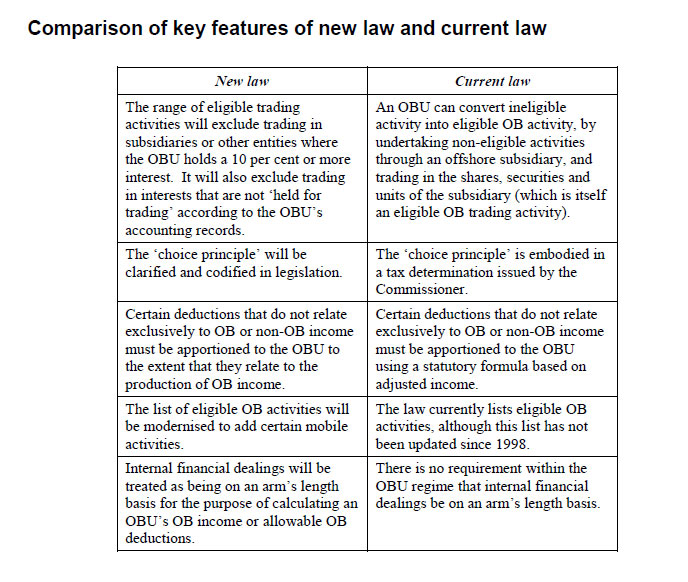The financial institutions supervisory levies are set to recover the operational costs of APRA and other specific costs incurred by certain Commonwealth agencies and departments, including the Australian Securities and Investments Commission, the Australian Taxation Office, and the Department of Human Services.
By way of background, in December 2002, the Government adopted a formal cost recovery policy to improve the consistency, transparency and accountability of cost recovered activities and promote the efficient allocation of resources. Cost recovery involves government entities charging individuals or non-government organisations some or all of the efficient costs of a specific government activity.
On 16 April 2014, Treasury released a paper responding to the submissions received on the methodology review and its conclusions informed last year’s discussion paper on the levies to be imposed in 2014-15. In the 2014-15 discussion paper, industry was further asked to provide Government with their views in relation to whether: The 2014-15 levies should be calculated in the same way as the 2013-14 levies (Option 1), or; For the 2014-15 levies, the costs of all activities, except for APRA’s prudential supervision, should be allocated to the unrestricted levy component with the maximum cap for superannuation funds lowered to reflect the cost of SuperStream being met from the unrestricted component, and Pooled Superannuation Trusts to be levied at a lower rate to reflect the lower intensity of regulation required (Option 2).
Industry was also asked to provide Government with their views on whether the SuperStream levy payable should continue to be calculated on a net assets basis or with reference to the number of superannuation fund members. Following industry consultation, the Government elected to determine the levies payable in 2014-15 using the methodology outlined in Option 2. This methodology will be used to determine the levies payable in 2015-16.
APRA’s net funding requirements under the levies for 2015-16 is $125.1 million, a $2.7 million (2.2 per cent) increase relative to budget for 2014-15. $6.6 million of these costs will be met through other sources of APRA revenue (referred to as net cost offsets) and Government appropriations, including a special levy for the National Claims and Policies Database (NCPD). Taking into account $1.0 million in projected over-collected 2014-15 levies to be returned to industry, APRA’s underlying net levies funding requirement for 2015-16 is $117.5 million, an increase of $0.6 million (0.5 per cent) relative to budget for 2014-15.
A component of the levies is collected to partially offset the expenses of ASIC in relation to consumer protection, financial literacy, regulatory and enforcement activities relating to the products and services of APRA regulated institutions as well as the operation of the Superannuation Complaints Tribunal (SCT). In addition, the levies are used to offset the cost of a number of Government initiatives including the over the counter (OTC) derivatives market supervision reforms and ASIC’s MoneySmart programmes. $28.2 million will be recovered for ASIC through the levies in 2015-16.
Funding from the levies collected from the superannuation industry includes a component to cover the expenses of the ATO in administering the Superannuation Lost Member Register (LMR) and Unclaimed Superannuation Money (USM) frameworks. The estimated total cost to the ATO of undertaking these functions in 2014-15 is $18.3 million, of which $7.1 million was recovered through the levies. In 2015-16, it is estimated that the total cost to the ATO in undertaking these functions will be $17.9 million with the full amount to be recovered through the levies in line with the requirements of the Government’s CRGs.
The Department of Human Services administers the early release of superannuation benefits on compassionate grounds. The compassionate grounds enable the Regulator (the Chief Executive of Medicare) to consider the early release of a person’s preserved superannuation in specified circumstances. In 2013-14, the Early Release of Superannuation Benefits programme received 19,286 applications. This was a 7 per cent increase compared with the previous year. In 2014-15, the Early Release of Superannuation Benefits programme is forecast to receive approximately 20,500 applications. This will represent an approximate increase in volume of 6.3 per cent compared with the previous year.
The programme is expected to cost the Government $4.7 million in 2015-16 and, in line with the CRGs, this amount will be recovered in full through the levies.
Announced as part of the former Government’s Stronger Super reforms, SuperStream is a collection of measures that are designed to deliver greater efficiency in back-office processing across the superannuation industry. Superannuation funds will benefit from standardised and simplified data and payment administration processes when dealing with employers and other funds and from easier matching and consolidation of superannuation accounts. The costs associated with the implementation of the SuperStream measures are to be collected as part of the levies on superannuation funds. The levies will recover the full cost of the implementation of the SuperStream reforms and are to be imposed as a temporary levy on APRA-regulated superannuation entities from 2012-13 to 2017-18 inclusive. The levy payable is subject to the Minister’s determination. The costs associated with the implementation of the SuperStream reforms are estimated to be $61.8 million in 2015-16, $35.5 million in 2016-17, and $32.0 million in 2017-18.
The Treasury paper, prepared in conjunction with the Australian Prudential Regulation Authority (APRA), seeks submissions on the proposed financial institutions supervisory levies that will apply for the 2015-16 financial year. Closing date for submissions: Wednesday, 10 June 2015

